|
All in-store sales of Sabine’s work are 10% off this month. Tell us a little about yourself. My interest in art was stirred by my art teacher in Germany who introduced us to many art forms, let us experiment with different mediums, and took our class to visit art museums. But it was not until the early 90s that my focus changed from admiring other artists work to getting actively involved in the creative process. When I took a stained glass class I knew that this is what I wanted to do. I find the process of making a stained glass piece deeply satisfying, and seeing how the light enhances the colors and textures of the finished artwork is always exciting to me. How long have you been part of Commonwheel? 9 years What does making art mean to you? Working with glass makes me happy and gives me inner peace. I strive to combine form, texture and color into a harmonious piece of artwork that will transform and brighten the surrounding space. Nobody said it better than Louis Comfort Tiffany: “Color is to the eye what music is to the ear”. What are you currently working on? Currently I am finishing up some nature pieces and am starting to create smaller suncatchers as well as fused glass jewelry for our upcoming Holiday Market. Tell us about your process—walk us through the steps of your flowing creativity to achieve one of your works. My process starts with drawing a design followed by the selection of glass. This is the creative and most crucial part and applies to large windows as well as to my smaller table art and suncatchers. After that it is mostly craft: cutting, grinding, foiling, soldering, reinforcing and applying patina. Most of my pieces are done using the copper foil technique which was made popular by Louis Comfort Tiffany as it allows for more intricate designs than the traditional lead came. What reaction do you want of the public looking at your artwork? Adding a stained glass art piece to a room will transform the mood of the space and I hope that my composition of color, texture and movement will brighten the viewer’s spirits. What is your favorite piece recent work? And why? I like them all. Where can we find your work?
Only at Commonwheel Artists Co-op.
0 Comments
Compiled by Juanita Canzoneri Our annual Holiday Market opens this Friday. We asked all of this year’s participants a few questions to help you get to know them a little better. So, let us introduce you to a few of this year’s artists. Connie Lorig In a short paragraph, tell us about yourself. I'm a native of Colorado Springs and 41-year Manitou resident. I've been a jewelry artist for more than 30 years and am primarily self-taught. In 2010 I began experimenting and fell in love with mixed metal cold connections. I work primarily in copper and brass with accents of pewter, silver, niobium, iron, and any other fun metals I can find. I love vintage brass and copper pieces, and often incorporate them in my work. What does making art mean to you? Connie Lorig: Making art takes me from one world to another. I seldom know exactly what I'm going to make when I walk into my studio, but I do know that my creative side will unlock and it's time to play. For this show specifically, tell us about your process—walk us through the steps of your flowing creativity to achieve one of your works. Connie Lorig: My Holiday Market ornaments are made from bronze and copper metal clay. I found or created textures and molds that fit the theme: stars, trees, crosses, etc. I hand molded or carved the clay to fit the form, let the clay dry, decorated and sanded the piece if needed and then fired it in my kiln. After firing, all the pieces were polished. Some were then patinated and re-polished. David Smith In a short paragraph, tell us about yourself. I am a retired Air Force pilot living in Colorado Springs and I currently fly for Southwest Airlines. I got started building mosaic tile tables in 2009 after my wife bought one at a craft fair. I looked at the table, said I can do that and my hobby was born. I added trays and wall art a few years ago. I normally try to paint a scene on my tables or I do custom work. Some of the scenes I try to replicate from what I see from my cockpit window! What does making art mean to you? I really enjoy the challenge of producing the perfect piece for my customers. It is wonderful to see the expressions on their faces as they see their table, tray or wall art for the first time. I am proud to produce a piece of art that is also functional. As a rule I do not cut the tile, but instead use a hammer to break the tile into pieces and like a jig saw puzzle lay the scene out. Obviously for some of the more complex scenes I do use a tile saw. I have about 30 plastic shoe boxes with pieces of tile in them and many other boxes of glass and specialty tile in my garage For this show specifically, tell us about your process—walk us through the steps of your flowing creativity to achieve one of your works. For the trays I try to find nice trays and then picture what kind and color scheme of tile will make the trays uniquely beautiful. Juanita Canzoneri In a short paragraph, tell us about yourself. I’ve been working in mosaics since 2001 and in the fiber arts since I was a child. I’ve seen evidence of a strong correlation between the 2 media in other mosaic artists and have long sought out a way of combining my fiber work with my glass mosaics. What does making art mean to you? I’ve been a maker all my life but for me “art” specifically connotes beauty along with any functionality or utilitarianism. Art evokes emotion, and, for me, emotion evokes touch. So, my work must be able to be touched. For this show specifically, tell us about your process—walk us through the steps of your flowing creativity to achieve one of your works. In thinking on how to create “wintery” or holiday art my first thought was to crochet snowflakes out of a very fine cotton thread. Then the task became figuring out what matrix would work best to solidify this fine work. Through trial and error, I hit upon encasing my fiber pieces in clear acrylic resin. It’s a new material for me and I’m still learning my way through the process, but I’m very excited about the results so far. What emotions/reactions/thoughts do you want to cause/explore/achieve on the public looking at your artwork? With all my little pieces I strive to evoke a feeling of fun, of joy, and a way to brighten up a dull corner or unused space. Michael Baum In a short paragraph, tell us about yourself. I started life on the road. My first home was a travel trailer journeying across the heartland of the nation. I think this is where I first fell in love with the landscape and the natural world. I've been on that journey my entire life. I studied fine art and anthropology at Wright State University in Dayton, Ohio, earning a bachelor of fine art degree. My real education began when I journeyed west to Colorado. I’ve been exploring the West almost forty years and barely scratched the surface. I’ve been painting it almost as long and feel like I’m just getting started. The beauty of light playing across the land goes beyond the visual and digs deep into the soul. I work in my studio in Manitou Springs and get out on the road as often as possible, still journeying. What does making art mean to you? Making art is the way I respond to the world. It’s the way I communicate with the world. It’s what I give back to the world. For this show specifically, tell us about your process—walk us through the steps of your flowing creativity to achieve one of your works. I produce these giclée prints from original oil paintings. In my painting I want to convey my experience in the western landscape—not just the purely visual, but also the feel of a place, how it digs deep into the heart and soul. I want the viewer to experience what I experienced, to have the thoughts and questions I had. I do most of my work in the studio and occasionally painting on site in the landscape. I spend a lot of time gathering images of places that speak to me, both locally and on road trips I take across the Southwest. I don’t just take photos. I take in as much of the environment as I can. Not just how it looks, but how it feels. How does the earth smell? Is there a breeze? What do I hear? What do I feel in this place? Is it lonely? Is it energizing? Is it welcoming? Mysterious? All of this goes with me back to the studio where I try to visually express it in a painting. A key to this is light. Light not only carries the image to our eyes, but delivers the other dimensions of the experience as well. For the whimsical pieces I drop the photo altogether and create the entire image in my mind, but always based on actual experience. A successful painting is one that delivers a total experience. Teri Rowan In a short paragraph, tell us about yourself. My father gave me the gift of a camera when I was six years old. From then on, I was hooked. That little Kodak Instamatic went everywhere I did. In 1993, years on down the line, I began formal training, and soon the student became teacher and artist. Over time I have won awards and worn many hats: dark room technician, studio photographer, tutor in digital art, gallery director and curator. Lastly, and most happily, artist. I find inspiration in many places, in nature, but also song lyrics, books I read, poetry, films and everyday life. I have two series that are currently in production. The first is based a woman’s body metamorphizing into other forms, the second is a fantasy landscape series that features my native Colorado. The most popular images contain parts of the burn scars from the Hayman and Black Forest Fires. Recently I’ve started printing on metal. I am a long way away from the darkroom these days. My work can be found "live" in Commonwheel Artist Co-op, in Manitou Springs, Colorado, where I am a member. What does making art mean to you? It is my way of expressing my inner self. Whether you are looking at a fantasy world of burned trees or a magical mermaid. This is who I am. For this show specifically, tell us about your process—walk us through the steps of your flowing creativity to achieve one of your works. I created, “A Winter’s Tale”, for Holiday Market. I knew what photo shoot I wanted to use, as I wanted to embody Colorado, as well of the feeling of Winter. It was a matter of selecting the right image and then going from there. I turned a day scene into evening and added the magic of snow, a crescent moon, some crystalline eruptions, and a snow hare. The photo was originally shot in Black Forest looking towards the mountains. What emotions/reactions/thoughts do you want to cause/explore/achieve on the public looking at your artwork? When I look at, “A Winter’s Tale”, it brings to me a sense of stillness and peace, as well as a bit of the magic of this time of year. Art is subjective. I don’t create pieces with the hopes of causing a certain response. The viewer will feel something related to their own personal experiences. Sabine Wachs “The process of taking sheets of colored glass and transforming them into an art piece - big or small, simple or elaborate - is deeply satisfying to me. Stained glass magically changes the atmosphere of any room by filtering and softening harsh light through color and texture. It invites the eye to rest and enjoy a moment of peace and reflection. For the holidays I have created glass pieces that express the spirit of the season and add to a festive mood.”
For this year’s Holiday Market Sabine is creating a number of glass ornaments as well as fused glass earrings and necklaces. by Leti Wesolowski We put out a call for mandala-related art and our local artists stepped up to the challenge. The “Mandala” show currently in our gallery is the result. 17 artists brought in mandala-related art from diverse points of views and inspiration—from patterns of nature, symbols from different cultures, colors, and the practice of centering and meditation. The works explore multiple medias but all embody the concept of “mandala”: fused glass; watercolor; digital photography; bronze, silver, and copper; precious metal clays; mixed media; stained glass; laser-cut wood; hand stamped clay; polymer clay; engraved terracotta; vinyl records; color pencil drawings; and more. We invite you to contemplate mandalas made by local artists and discover which one evokes feelings of peace, balance, unity and strength that resonate with you. Let them work their magic on your life and allow your mind to wander into the beauty of mandalas. “Mandala” comes from a Sanskrit word that means “circle or disc”. In art, mandala is often a symbolic pattern usually in the form of a circle within a square divided into four symmetric sections containing a unifying center from which geometric shapes and symbols radiate outwards. “The mandala is an archetypal image whose occurrence is attested throughout the ages. It signifies the wholeness of the Self.” —Carl G. Jung, Memories, Dreams and Reflections Embraced by many religions and cultures around the world, a mandala represents wholeness and the connection between inner self and outer reality. “In Christianity, there are a number of sacred images and ritual invocations that use the circular shape to connect the spiritual realm with the earthly realm”, says figurative sculptor Marica Hefti. “The placement of divine beings, angelic figures, and holy personages at crucial positions within the circular (stained glass) windows (of Christian cathedrals) establishes the powerful storyline of Christian beliefs”. Hindus were one of the first people to use mandalas as spiritual tools. Native Americans use mandalas as shields of good luck, prosperity, wealth and happiness. Buddhist monks create sand mandalas, a process that takes days to create, then sweep it and pour it into a river, to symbolize the never-ending cycle of life. “A concept of new beginnings, forms of life itself” says Tracey Eastland when asked to explain what a mandala means to him. Mandala is used in spiritual practices as a focal point for meditation, self-awareness, and healing. For digital photographer Teri Rowan, a mandala is “meant to inspire meditation and introspection” or can be admired for just its beauty. Metalsmith Kathleen Krucoff thinks a mandala is “a beautiful symbol to convey positive messages of encouragement and support”. In art, mandala has become a generic term for any diagram, chart, or geometric pattern that represents the center of the universe, metaphysically or symbolically. For Jewelry artist Connie Lorig, a mandala represents “a complex dance between unity and diversity, between the parts and the whole.” For artist Sheila Hewlett, mandala means the continuity of life. Commonwheel artist Julia Wright takes pictures of nature during her hikes and then edit them on her computer to create hypnotic mandalas. Designing a mandala is a unique personal experience in which the individual lets the creative mind to run free and find the symphony of shapes, colors and patterns to represent their unique sense of self and view of reality. Sculptor m.jo hart says “mandalas represent the process and meditation involved in creating her work”, which is focused on women’s issues, unique stories and experiences. Mandalas can be created by individuals to symbolize their journeys through life, their state of mind or to tell their personal story. Some of our artists got inspired by Celtic art, such as lampwork artists Jon Murray and Amanda Shotts who incorporate in their mandala barrettes “a circular pattern that has no beginning and no ending, signifying infinity of love!” Or Glass artist Sabine Wachs who “was drawn to the Celtic spiral mandalas used as symbols of the sun powering all life”. Jeweler Mary Cowdery got inspired by the yin-yang symbol, repetition and balance. Artist Ray Jordan loves bright whimsical colors. His biggest inspiration is combining bright colors with his love of painting, drawing and cutting wood. Kendrick Cowdery has a strong desire to maintain peace in his life. His handmade mandala lamp is built on mat board using a laser cutter and colorful translucent paper. Several artists took it as a chance to explore new themes and materials, such as mosaic artist Juanita Canzoneri who jumped at the opportunity to play with alcohol inks and raid her stash of stained glass. She found that, during the process, mos of her work reminded her of an art form from her childhood in eastern Pennsylvania. Others worked in new themes with their primary media, such as potter Jennifer Hanson who creates mandalas on her clay dishes with different hand stamps. Or illustrator and mixed media artist Kelly Green who finds that vinyl albums automatically lend themselves to the mandala format. Creating a mandala can be an enriching personal experience. To draw a mandala, one starts by “drawing the circle, setting an intention, centering through a meditation, usually start at the “bindu” sacred center and follow inspiration that comes” explains Mandala instructor Anne Roe. She sees mandalas “as “windows to the soul”, sacred circles and opportunities for the soulful self to express authentically”. Sometimes mandalas are created to evoke feelings of peace and contentment on the observer. Kathleen Krucoff, for example, wanted her pieces to “help the wearer feel empowered” focusing in tranquility and strength. Ray Jordan wanted to “bring a smile to the art viewer mind and make them think”.
|
Juanita Canzoneri
|



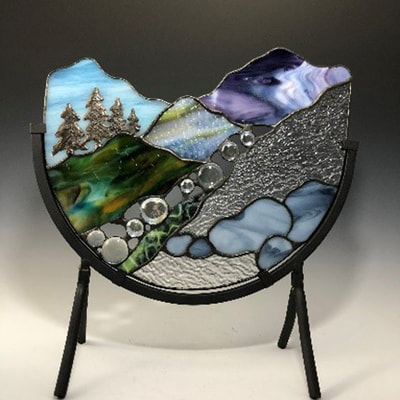

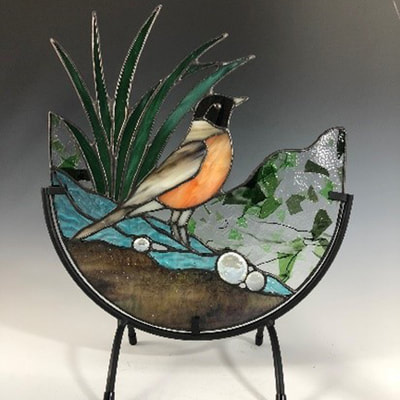








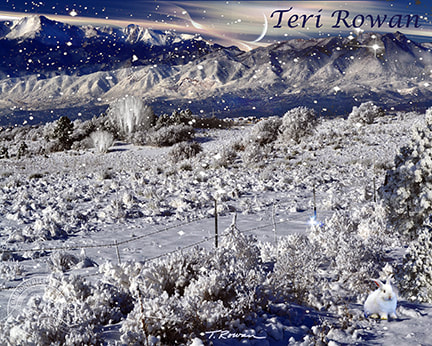



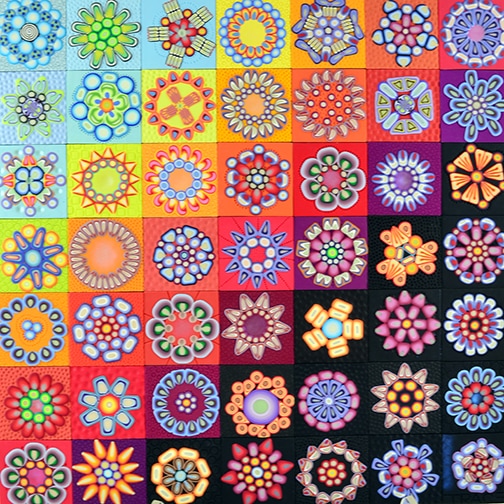



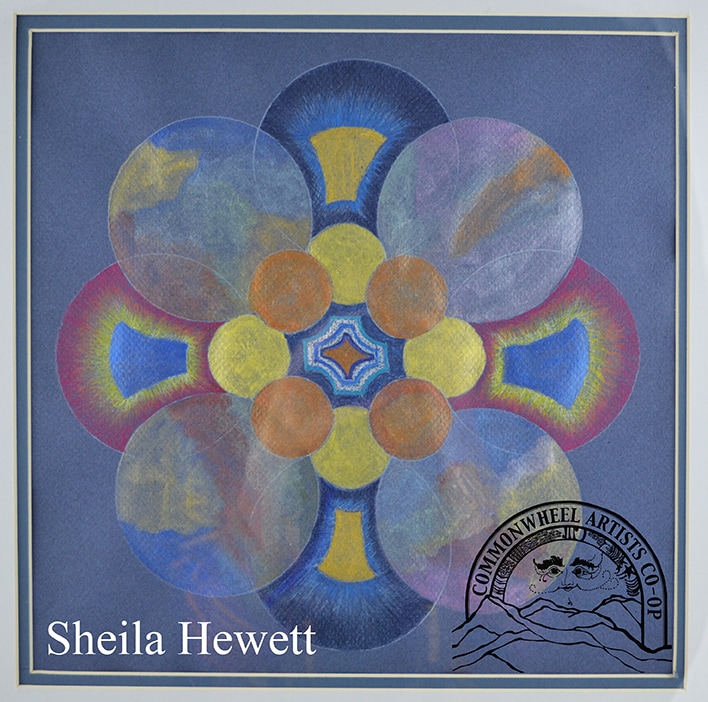





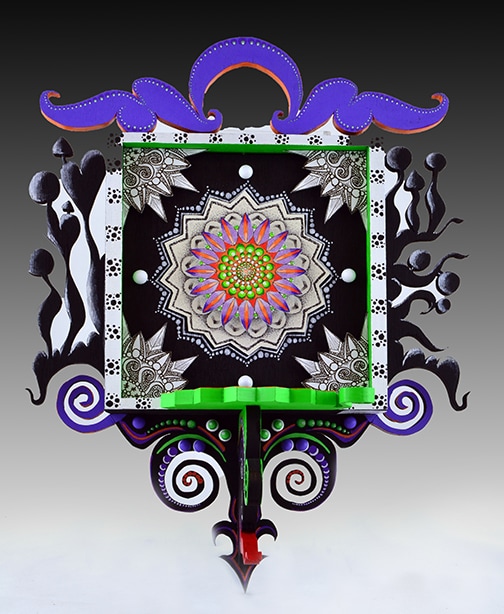



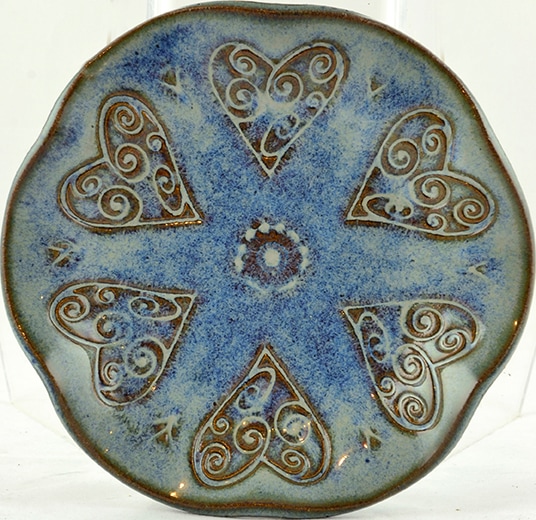


 RSS Feed
RSS Feed